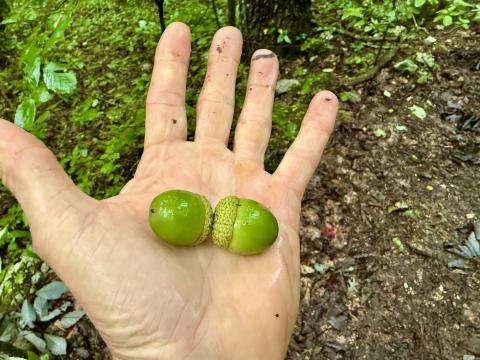Mast Years: When Critters Eat Good

Chestnut oak is just one of several oak species in our local forests, and are very plentiful this year
By Steve Roark
Volunteer, Cumberland Gap National Historical Park
Many species of trees have “mast years”, when their seed/fruit production is extraordinarily high. And this year it looks to be Chestnut oak, whose acorns are thick on the ground right now. Mast refers to tree seeds that are a food source for wildlife. It comes from the old English word “maest”, referring to tree nuts that have accumulated on the forest floor. Hard mast includes all the nut trees, including oak (nine local species), hickory (four local species), walnut, beech, chinquapin, and hazelnut. Soft mast includes fleshy fruits like dogwood, sassafras, blackgum, blueberry, blackberry and cherry. The nut trees tend to have periodic bumper crop years, and when it happens, a mast year is conspicuous. Several years of low to moderate seed production will suddenly be augmented by a year when the trees are loaded. How tree species coordinate mast years all produce heavy at once is still a mystery, but it’s known trees communicate with each other through chemical signals passed through the air or through underground root/fungal connections and weather cues. You may notice that mast-consuming species such as squirrels, jays, turkey, grouse, and deer, and bear are more visible during masting years. In poor crop years, wildlife sightings drop as they move away in search of food.
This all begs the question: why do trees go through years of so-so seed production and then suddenly flood the market? Masting is probably an adaptation to aid the trees in escaping the ravages of seed consumers. By alternating between occasional bumper crops and the more usual smaller crops, trees conserve energy, enabling them on a given year to produce more seeds than all the seed consumers can eat. Squirrels and deer can eat all they want, but there will still be plenty of acorns on the forest floor to sprout into oak seedlings.
A UT wildlife professor once made an observation that bumper crop years often follow drought-stricken summers. This may be a reaction to stress where the trees think they may not survive and so try extra hard to procreate with heavy seed production.
An interesting book to read about mast years and life in the forest is Eastern Forests, by John Kricher and Gordon Morrison.
- Log in to post comments